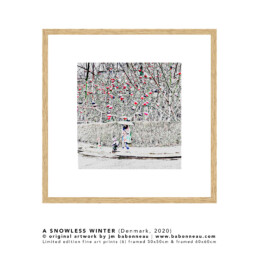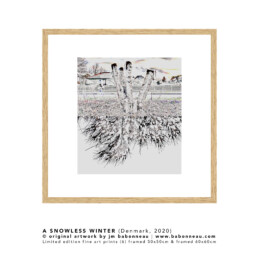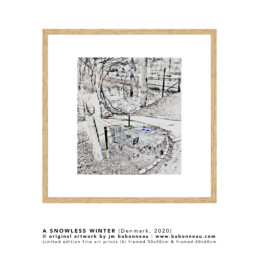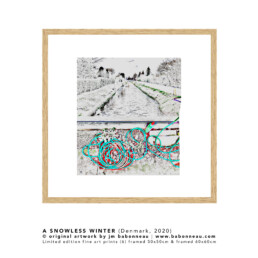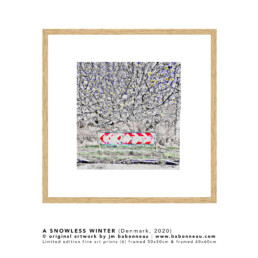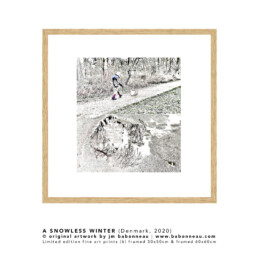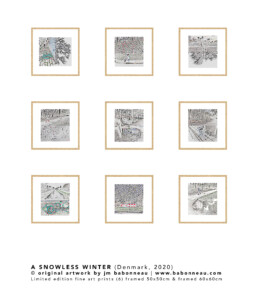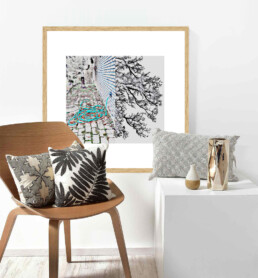A SNOWLESS WINTER (Denmark, 2020)
© photo series by jm babonneau | www.babonneau.com
A SNOWLESS WINTER (Denmark, 2020)
© photo series by jm babonneau | www.babonneau.com
Signed & numbered (n/6) limited edition pigment art prints in 2 sizes :
- 60 x 60 cm (incl. margin)
- 50 x 50 cm (incl. margin)
on Hahnemühle archival paper 350 gsm,
framed in natural wood frames under standard glass
(special type of glass with a surcharge upon request).
Prices are discounted on this website as direct acquisition from the artist
(without gallery commission).
Example : Archival print in 60 x 60 cm wood frame (with standard glass):
1999,- Dkr // 270,- Euros // 325,- US$
(+ shipping).
Artworks can also be acquired without frames and sent in protective cylinders (incl. insurance).
Order through the webshop
or via e-mail : babonneau@gmail.com
STATEMENT OF INTENT
UN HIVER SANS NEIGE | A SNOWLESS WINTER
The series of photographs “A winter without snow” created around Copenhagen (in its northern suburbs and small towns adjoining residential villa districts), in Denmark, in winter 2020, contains several ideas:
• the creative diversion of a photographic application under the iOS operating system for iPhone, operating with an algorithm initially designed to digitize physical documents and whiteboards, flat or in perspective, which I chose to use for an unexpected purpose: photographing architecture, parks and street scenes in different parts of Greater Copenhagen. The degradation of image resolution and color space creates an aesthetic that captures a snowless winter in Copenhagen in early 2020 with the series’ paradoxically white washed images that can give the illusion of a snowy urban space. The title “A Snowless Winter” deliberately contradicts the whiteness of the images.
• Scenes of tamed nature in suburban parks, on streets in residential areas, and in cemeteries, where joggers run, residents take their dogs for fresh air, and mothers take walks with their strollers, almost become drawings where the “photographic” has been obliterated from its prefix “photo” in favor of its suffix “graphic”. This unusual process, directly producing these images as they are, without further editing – apart from the construction of the diptychs and triptychs, could imply that our trivial daily reality can appear differently through an “apocalyptic” filter, that our daily routines could be more fragile and precarious than we imagine. An unexpected event can upset them. Global warming, melting polar ice or the coronavirus can suddenly change our lives. The whitish images in the series can be interpreted as a metaphor for contemporary scenes turning into nostalgic memories, much like the snowy landscapes of my childhood in the 70s. Memory fails us with age and the reality of the past metamorphoses into an old ideal dream.
• The diptych and triptych mounts, where two or three images are put in dialogue with each other in an almost invisible way sometimes, create in their juxtaposition a new fictitious landscape, perhaps a parallel reality in which the imagination can circulate freely. These associations want to produce small visual poems. This woman with an umbrella walking a young child is overhung by a rain of enormous red berries. This dog walker has no reflection in the puddle. These cut tree trunks adjoin the wooden barriers that they may become. These minimalist traffic signs offer an ironic counterweight to the abundance of natural trees featuring a complex and mysterious geometry.
These white landscapes are a simulacrum of Nordic winter, which the snow has not covered with its white coat. Is climate change the cause? Is the end of our modern civilizations near? These images try to evoke a latent upheaval that can challenge our ways of life. Beyond questioning our culturally-laden perception of reality, my approach rather tries to infuse a little poetry and beauty in the banal, in the destruction and taming of plants, of nature, in a privileged world that often remains blind to its privileges in the amnesia of the routines of daily life. I am the stranger who walks the streets and parks of a foreign country where I have spent many years and which I am still striving to rediscover by questioning my own habits and proven methods in my practice of the photographic medium.
ARTISTIC REFERENCES
In terms of the degradation of the image quality as an aesthetic, I was fascinated by the early Xerox photo books (1964-1970) by Japanese photographer Nobuyoshi Araki, back then at the start of his career. These toner-starved photocopied images show faces with grayish tones and washed-out shadows that can evoke the material wear and tear of images, the vanity of our existences whose memory of familiar faces erodes and eventually fades away over time. This quasi-solarization effect can also evoke the radiation effect of the American atomic bombs that Japan experienced in its flesh in August 1945. On the other hand, the very graphic images of urban and industrial landscapes, dilapidated surfaces and waste by Danish photographer Keld Helmer-Petersen (1920-2013) whose retrospective I saw in autumn 2019 at the Danish National Museum of Photography in Copenhagen also imbued me with their beauty.
This process, unprecedented in my own photographic vocabulary, allowed me to explore a new tool for creating images, to rediscover landscape photography and “street photography”, but also the Danish capital and its surroundings where I have lived for 17 years, with a fresh perspective.
Jean M. Babonneau
Copenhagen, 15 mars 2020
–


